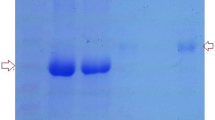Abstract
Clinically relevant Streptococcus spp. were tested for their susceptibility towards human serum transferrin (TR) and lactoferrin (LF). Neither clinical isolates or type strains were inhibited by transferrins (5 mg/ml). All species tested were shown to be able to grow under iron-limiting conditions (<0.1 μM) and this might account for the lack of TR or LF activity towards streptococci. Even if not sensitive to LF and TR, some species were shown to bind LF in the apo-form.
Similar content being viewed by others
References
Aisen P (1980) The transferrins. In: Jacobs A, Worwood M (eds) Iron in biochemistry and medicine. Academic Press, London, pp 87–129
Arnold RR, Brewer M, Gauthier JJ (1980) Bactericidal activity of human lactoferrin: sensitivity of a variety of microorganism. Infect Immun 28:893–898
Beigthon D, Whiley RA, Homer KA (1990) Transferrin binding by S. oralis and other oral streptococci. Microb Ecol Health Dis 3:145–150
Bezkorovainy A (1980) Microbial iron uptake and the antimicrobial properties of transferrins. In: Bezkorovainy A (ed) Biochemistry of non-heme iron. Plenum Press, New York, pp 305–342
Brock JH, Janet N (1983) The effect of desferrioxamine on the growth of S. aureus, Y. enterocolitica and S. faecalis in human serum: uptake of desferrioxamine-bound iron. FEMS Microbiol Lett 20:439–442
Bullen JJ, Griffiths E (1987) Iron and infection. J Wiley and Sons, New York
Ellison RT, III, Giehl TJ (1991) Killing of Gram-negative bacteria by lactoferrin and lysozyme. J Clin Invest 88:1080–1091
Evans SL, Arceneaux JEL, Byers BR, Martin ME, Aranha H (1986) Ferrous iron transport in S. mutans. J Bacteriol 168:1096–1099
Geesey GG, Jang L (1989) Interactions between metal ions and capsular polymers. In: Beveridge TJ, Doyle RJ (eds) Metal ions and bacteria. J Wiley and Sons, New York, pp 325–357
Gutteberg TJ, Dalaker K, Vorland LH (1990) Early response in neonatal septicemia. The effect of E. coli, S. agalactiae and tumor necrosis factor on the generation of lactoferrin. AMPIS 98:1027–1032
Hughes AH, Hankock IC, Baddiley J (1973) The function of teichoic acids in cation control in bacterial membranes. Biochem J 132:83–93
Hunter RL, Bennett B, Towns M, Vogler WR (1984) Transferrin in disease: defects in the regulation of transferrin saturation with iron contribute to susceptibility to infection. Am J Clin Pathol 81:748–753
Marcelis JH, Den Daas-Slagt HJ, Hoogkamp-Korstanje JAA (1978) Iron requirement and chelator production of staphylococci, S. faecalis and enterobacteriaceae. Antonie van Leeuwenhoek 44:257–267
Martin ME, Strachan RC, Aranha H, Evans SL, Salin ML, Welch B, Arceneaux JEL, Byers BR (1984) Oxygen toxicity in S. mutans: manganese, iron and superoxidodismutase. J Bacteriol 159:745–749
Menozzi FD, Gantiez C, Locht C (1991) Identification and purification of transferrin- and lactoferrin-binding proteins of B. pertussis and B. bronchiseptica. Infect Immun 59:3982–3988
Neilands JB (1974) Microbial iron metabolism. Academic Press, New York
Oka K, Hagio Y, Tetsuoh M, Kawano K, Hamada T, Kato T (1987) The effect of transferrin and lysozyme on antibacterial activity of amniotic fluid. Biol Res Preg 8:1–6
Phelps CF, Antonini E (1975) A study of the kinetics of iron and copper binding to hen ovotransferrin. Biochem J 147:385–391
Schryvers AB, Morris LJ (1988) Identification and characterization of the human lactoferrinbinding protein from N. meningitidis. Infect Immun 56:1144–1149
Terleckyj B, Willett NP, Shockman GD (1975) Growth of several cariogenic strains of oral streptococci in a chemically defined medium. Infect Immun 11:649–655
Valenti P, Visca P, Antonini G, Orsi N (1986) Interaction between lactoferrin and ovotransferrin and Candida cells. FEMS Microbiol Lett 33:271–275
Visca P, Dalmastri C, Verzili D, Antonini G, Chiancone E, Valenti P (1990) Interaction of lactoferrin with E. coli cells and correlation with antibacterial activity. Med Microbiol Immunol 179:323–333
Winkelmann G, van der Helm D, Neilands JB (1987) Iron transport in microbes, plants and animals. VCH Publishers, Weinheim
Author information
Authors and Affiliations
Rights and permissions
About this article
Cite this article
von Hunolstein, C., Luisa Ricci, M., Valenti, P. et al. Lack of activity of transferring towards Streptococcus spp.. Med Microbiol Immunol 181, 351–357 (1992). https://doi.org/10.1007/BF00191547
Received:
Issue Date:
DOI: https://doi.org/10.1007/BF00191547




